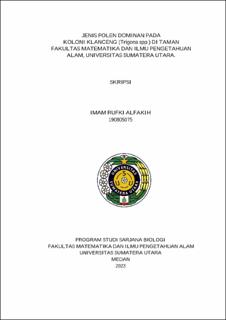| dc.description.abstract | The use of park as a conservation area is one of the breakthroughs made by FMIPA campus in Universitas Sumatera Utara. It becomes eco green campus. Bee Trigona sp. is a type of honey-producing bee that does not have a sting or commonly known as stingless bee. Various type of plants grow in the park as a food of insect pollinators such as Trigona sp. bee, that introduced around the park. This research aims to identify plants feed by the bee, analyze pollen types, and physical factors around the FMIPA park. The research method used acetolysis to identify various plant, collected pollens and observe bee activity patterns which were carried out to support this research data. Measured physical factor include temperature, humidity, light intensity, and wind speed. The results of this study indicate that every colony has different pollen types. Predominant pollen in 1st colony was Adiantum sp., whereas in 2nd and 3rd colony were Barringtonia asiatica. There was also a difference in feed diversity in each colony, indicating that 1st and 2nd had a high index of feed diversity, 4.0501 and 5.3338 respectively, meanwhile 3rd colony had a moderate index of diversity of feed, 2.8107. Activity pattern 2nd colony has a slightly better than 1st colony but both are classified as stable. 3rd colony is classified as abnormal because the 3rd colony introduce from bamboo hive to the wood hive meanwhile the colony still adapting to the environment. The physical factors found around the FMIPA park indicate that this location can be used as a habitat for bee colonies Trigona sp | en_US |





